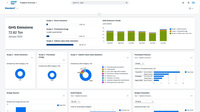Salesforce Net Zero Cloud vs. SAP Sustainability Footprint Management
Salesforce Net Zero Cloud vs. SAP Sustainability Footprint Management
| Product | Rating | Most Used By | Product Summary | Starting Price |
|---|---|---|---|---|
Salesforce Net Zero Cloud | N/A | Salesforce's Net Zero Cloud enables users to integrate a complete sustainability management solution into an organization. | $48,000 per year | |
SAP Sustainability Footprint Management | N/A | SAP Product Footprint Management is a software solution used to calculate product footprints periodically and at scale across the entire product lifecycle. | N/A |
| Salesforce Net Zero Cloud | SAP Sustainability Footprint Management | |||||||||||||||
|---|---|---|---|---|---|---|---|---|---|---|---|---|---|---|---|---|
| Editions & Modules |
| No answers on this topic | ||||||||||||||
| Offerings |
| |||||||||||||||
| Entry-level Setup Fee | No setup fee | No setup fee | ||||||||||||||
| Additional Details | — | — | ||||||||||||||
| More Pricing Information | ||||||||||||||||
| Salesforce Net Zero Cloud | SAP Sustainability Footprint Management | |
|---|---|---|
| Small Businesses | No answers on this topic | No answers on this topic |
| Medium-sized Companies | Wolters Kluwer CCH® Tagetik Score 8.3 out of 10 | Wolters Kluwer CCH® Tagetik Score 8.3 out of 10 |
| Enterprises | Wolters Kluwer CCH® Tagetik Score 8.3 out of 10 | Wolters Kluwer CCH® Tagetik Score 8.3 out of 10 |
| All Alternatives | View all alternatives | View all alternatives |
| Salesforce Net Zero Cloud | SAP Sustainability Footprint Management | |
|---|---|---|
| Likelihood to Recommend | 10.0 (1 ratings) | 7.6 (5 ratings) |
| Salesforce Net Zero Cloud | SAP Sustainability Footprint Management | |
|---|---|---|
| Likelihood to Recommend |  Salesforce
| SAP
|
| Pros |  Salesforce
| SAP
|
| Cons |  Salesforce No answers on this topic | SAP
|
| Alternatives Considered |  Salesforce
| SAP
|
| Return on Investment |  Salesforce
| SAP
|
| ScreenShots | SAP Sustainability Footprint Management Screenshots |


